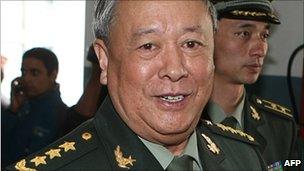China-US military 'harmony' masks tensions
- Published

General Chen Bingde's visit is the first to the US by China's defence chief for some seven years
China's top military commander, General Chen Bingde, is in the United States this week for talks with his counterpart, the chairman of the US Joint Chiefs of Staff, Admiral Mike Mullen.
He is also visiting a variety of military bases and training facilities.
This is the first visit by China's defence chief to the US for some seven years. Indeed military-to-military ties have lagged behind improvements in the wider bilateral relationship, which was symbolised by the visit of Chinese President Hu Jintao to Washington in January of this year.
Gen Chen's trip began in unusual style with Chinese and US Army bands playing a joint concert at the Kennedy Arts Centre in Washington DC.
Harmony in military-to-military relations is very much the intended tone for this visit. But how far can this transcend a developing strategic rivalry?
During his military tour around America, Gen Chen will see for himself the extraordinary technical abilities of the US armed forces.
China, of course, is racking up some impressive technical achievements of its own. It has developed a land-based long-range ballistic missile capable of striking US carrier battle groups far out to sea.
This "carrier-killer", as it has been dubbed in US naval circles - the DF-21D Anti-Ship ballistic missile - is believed to have achieved an initial operational capability.
China's own first aircraft carrier - a reconditioned former Soviet vessel - is close to beginning sea trials. And over recent months there have been tantalising glimpses of China's new, stealthy, fifth-generation fighter aircraft - dubbed in the West the J-20.
Invisible threat
The aim of China's extensive military modernisation is to extend China's military reach well beyond its own shores and to potentially neutralise weapons systems where the US has a dominant advantage.
Part of China's potential threat is the weaponry that you cannot see. Beijing is believed to have invested heavily in offensive cyber capabilities; the capacity to attack computer systems and networks.

China's J-20 prototype had its maiden flight in Chengdu earlier this year
None the less it is going to be a long time before China can seriously rival US military clout. Chinese naval operations far from its own shores are, for now at least, a novelty.
It was much commented on when Beijing sent a warship to Libya to help with the evacuation of its nationals. And China's small involvement in anti-piracy operations in the Gulf of Aden and off Somalia is a fascinating portent of things to come.
This yields a fascinating insight into what is driving China's expanding military reach. It is easy to stack up US and Chinese naval capabilities against each other - that's why the so-called "carrier-killer" missile has drawn so much attention in US naval circles.
Of course there is a dimension of strategic rivalry between Washington and Beijing; something that is likely to grow in the future.
But one of the main drivers of China's military modernisation is its own broadening horizons; an economic footprint that now extends across the globe and which inevitably broadens China's military horizons as well.
The US has sought to encourage China as a rising economic power to become what the US terms "a responsible stake-holder" in the global system. To an extent the same approach may well be applicable in military matters as well.
But nobody can ignore the underlying strategic rivalry.
Gen Chen's visit to the US has drawn a strongly favourable press in China; a signal of the importance that the Chinese authorities are now placing on better military ties.
But there should be no illusions. Superficial harmony inevitably masks significant underlying tensions.
As an editorial this week in the state-run China Daily newspaper put it: "Sino-US military ties still face three major obstacles: US arms sales to Taiwan; frequent reconnaissance by US naval ships and aircraft in the waters and airspace of China's exclusive economic zones, and the restrictions imposed by some US domestic laws on exchanges and technical co-operation between the two armed forces."
None of that is going to change in the near-future.
- Published13 April 2011
- Published11 January 2011
- Published17 August 2010
- Published3 September 2010
- Published25 January 2011